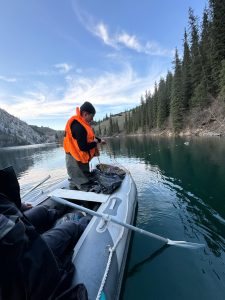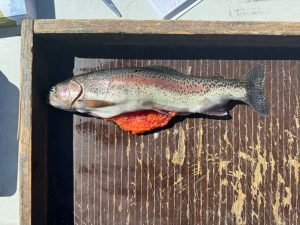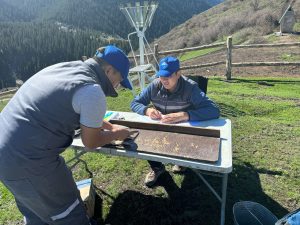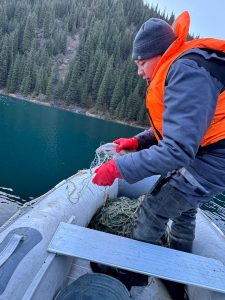
From April 16 to the present, research stuff FishRPC (head of the expeditionary unit, acting head. laboratories of ichthyology Sansyzbaev E.T., acting junior researcher Igilik R., laboratory assistant Abishev N.B.) scientific research is being carried out on the lakes of Lower and Middle Kolsai located in a specially protected natural area (protected areas) of the State National Natural Park “Kolsai Kolderi” according to BP 021 (subprogram. 100) “Determination of fish productivity of fishery reservoirs and/or their sites, development of biological justifications for the maximum permissible volumes of catches of fish and other aquatic animals, the regime and regulation of fishing in fishery reservoirs of international, republican significance and reservoirs of the protected areas of the Balkhash-Alakol basin. Section: Reservoirs located in specially protected natural areas (protected areas) of the lake. Middle and Lower Kolsai.
The purpose of the work is to study trout reproduction on the Kolsai lakes. Currently, the expedition team is sampling ichthyological materials for biological analysis (size and weight indicators, sex determination and maturity stage of fish, age and fertility).
For reference: Lower and Middle Kolsai are located in the Almaty region. Comprehensive scientific research work has been carried out at the Kolsai Lakes by FishRPC since 2017. According to literary sources, the initial ichthyofauna of Lake Lower Kolsai consisted of native fish species – naked osman (Gymnodyptichus dybowskii, Kessler, 1874) and Tibetan stone loach (Triplophysa stolickai, Steindachner, 1866). The Middle Kolsai Lake was fishless. In 1965-1969, 3 and 5 thousand individuals of juveniles (fry) of rainbow trout were moved to Lower Kolsai and 1969 in the Middle Kolsai – 5 thousand individuals. The settlers subsequently successfully naturalized and formed self-reproducing populations, completely displacing the naked osman and partially Tibetan stone loach, which is very rare in catches.




